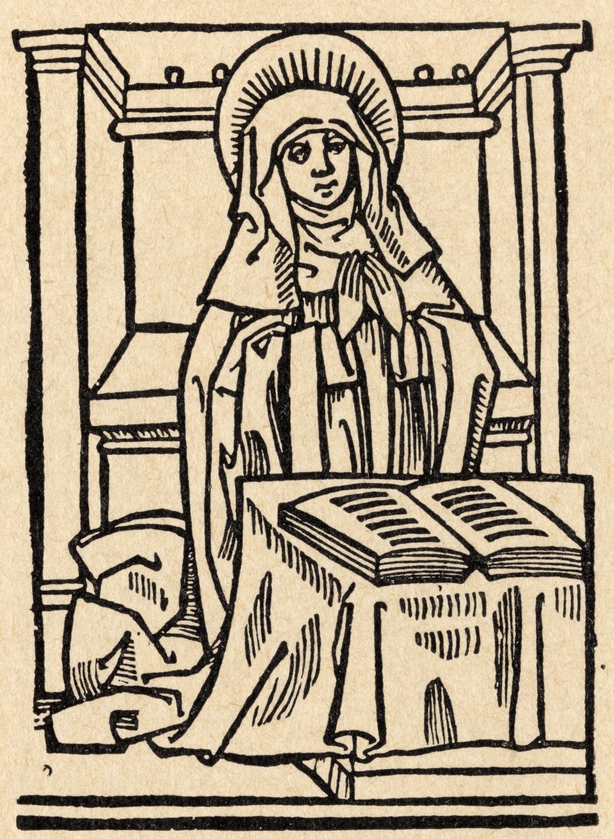Bridget has been honoured for centuries not only in Ireland but across continental Europe. Her dedication to charity and social justice meant that her reputation spread through monastic networks and religious orders throughout Britain and the Contininent.
Bridget or Bríghid's roots can be traced to the ancient Celtic goddess, a deity associated with fertility, poetry,and healing. As Christianity spread through Ireland, her image evolved into that of a Christian saint while retaining many elements of her earlier, pre-Christian counterpart.
This blending of traditions highlights Ireland’s ability to adapt and preserve its identity despite often-oppressive external cultural and political pressures and our colonial past.
While a great deal of folklore exists in relation to Bridget and her influence on Irish culture, historians still frequently stress that we are always learning when it comes to historical facts about her.

After a woodcut from 1492. (via Getty Images)
Elements of the Saint Bridget story that haven’t received as much attention as of yet, include her "European" aspects and the fact that, as with St. Patrick, she was often viewed as a symbol of Ireland itself and as a patron or protector of Irish culture.
Evidence of this is found in the many churches and holy wells dedicated to her, particularly in Scotland and Wales, where Irish missionaries endeavoured to continue her legacy.
On the Continent, also, her name was revered in places such as Belgium, Germany, and Scandinavia, where Irish monks promoted her ideals during the early medieval period.
The famous Bridgettine Order, founded by Saint Bridget of Sweden in the 14th century, further solidified her name in European culture. Scholars of medieval Europe have highlighted how her feast day on February 1st was marked across a wide range of countries and cultures, demonstrating the reverence in which St. Bridget was held far beyond Ireland’s shores.

As with St. Francis and another Irish woman saint, St. Gobnait of Ballyvourney, Cork, Bridget has always had a particular association with the natural world, agriculture, and animals in Irish tradition.
St. Bridget’s Day and the weeks that followed marked the beginning of spring in Irish tradition and coincided with Imbolc, the pre-Christian and Celtic celebration of the renewal of life, fertility, and growth and the return of longer days. Celebrations of Saint Bridget coincided with the land awaking from winter’s grip and the beginning of the farming season proper.
As folklore scholar Séamas Ó Catháin put it: 'The arrival of St. Brigit's feast day – 1 February –betokened a turning point in the year: the worst rigours of winter had been left behind and the onset of spring weather and the coming of new growth could now be confidently expected’.
The following verse, collected in Corca Dhuibhne, Kerry, stresses the link between St. Bridget’s Day and the beginning of the sowing season:
Ó Lá Fhéile Bríde amach bíonn na daoine ag cur na gcnap,
Bíonn an teas ag teacht sa ghréin agus na héin ag bailiú nead.
From Saint Bridget's Day onwards the people are out planting the big potatoes,
There's some heat in the sun and the birds begin making their nests.
We need your consent to load this rte-player contentWe use rte-player to manage extra content that can set cookies on your device and collect data about your activity. Please review their details and accept them to load the content.Manage Preferences
As with the groundhog in certain parts of the U.S., similar beliefs existed in relation to sightings of the hedgehog and the badger in Ireland during this period:
"Tagann an ghráinneog amach ar Lá Bríde as a poll agus má cíonn sí a scáil téann sí isteach arís ina poll, ach nuair nach bhfuil a scáil le feiceáil aici fanann sí amuigh; bíonn fios aici nuair a fheiceann sí a scáil nach bhfuil an geimhreadh thart fós."
The hedgehog emerges on Saint Bridget's Day and if she sees her shadow outside, she goes back into her burrow again, but if she can’t see her own shadow, she remains above ground. If she sees her own shadow, she knows that winter isn't over yet.




